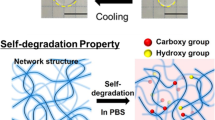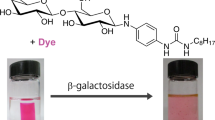Abstract
In this study, we sought to develop methods for amphiphilic engineering of bioresorbable polymers, sorbitan–poly(lactic acid) (sorbitan–PLA) and poly(ethylene glycol)–polylactic acid (PEG–PLA), by melt polycondensation of lactic acid in the presence of the binary initiators sorbitan and methoxy PEG in a single reactor. Briefly, oligo(lactic acid) (OLA) was first prepared by distilling water out of lactic acid under vacuum; then, sorbitan and methoxy PEG were introduced in the reactor, followed by the simultaneous polycondensation of OLA onto sorbitan and methoxy PEG, resulting in a mixture containing sorbitan–PLA/PEG–PLA copolymers. Without further purification, the recovered products were dissolved in saline buffer, mixed with squalane oil, and then homogenized to construct a stable colloidal vesicle. Then, we conducted a mechanistic study to progressively elucidate the relationship between the dispersion structure and the sustained release of a model protein bovine serum albumin. This one-pot approach has potential for applications and commercial use in the field of biodegradable controlled-release delivery systems.
This is a preview of subscription content, access via your institution
Access options
Subscribe to this journal
Receive 12 print issues and online access
$259.00 per year
only $21.58 per issue
Buy this article
- Purchase on Springer Link
- Instant access to full article PDF
Prices may be subject to local taxes which are calculated during checkout






Similar content being viewed by others
References
Kalasz H, Antal I. Drug excipients. Curr Med Chem 2006;13:2535–63.
Wakelin SH, Cooper S, Marren P, Shaw S. Sorbitan mono-oleate: a potential allergen in paste bandages. Contact Dermat 1996;35:377.
Sun H, Yang R, Wang J, Yang X, Tu J, Xie L, Li C, Lao Q, Sun C. Component-based biocompatibility and safety evaluation of polysorbate 80. RSC Adv 2017;7:15127–38.
Huang CY, Huang CH, Liu SJ, Chen HW, Leng CH, Chong P, Huang MH. Polysorbasome: a colloidal vesicle contoured by polymeric bioresorbable amphiphiles as an immunogenic depot for vaccine delivery. ACS Appl Mater Interfaces 2018;10:12553–61.
Ishikawa H, Suzuki T, Hayashi Y. High-yielding synthesis of the anti-influenza neuramidase inhibitor (-)-oseltamivir by three “one-pot” preparations. Angew Chem Int Ed. 2009;48:1304–7.
Li S, Anjard S, Rashkov I, Vert M. Hydrolytic degradation of PLA/PEO/PLA triblock copolymers prepared in the presence of Zn metal or CaH2. Polymer 1998;39:5421–30.
Rashkov I, Manolova N, Li SM, Espartero JL, Vert M. Synthesis, characterization, and hydrolytic degradation of PLA/PEO/PLA triblock copolymers with short poly(l-lactic acid) chains. Macromolecules 1996;29:50–6.
Wu H, Zhu H, Zhuang J, Yang S, Liu C, Cao YC. Water-soluble nanocrystals through dual-interaction ligands. Angew Chem Int Ed 2008;47:3730–4.
Maharana T, Mohanty B, Negi YS. Melt–solid polycondensation of lactic acid and its biodegradability. Prog Polym Sci 2009;34:99–124.
Shum HC, Zhao YJ, Kim SH, Weitz DA. Multicompartment polymersomes from double emulsions. Angew Chem Int Ed 2011;50:1648–51.
Huang MH, Chou AH, Lien SP, Chen HW, Huang CY, Chen WW, Chong P, Liu SJ, Leng CH. Formulation and immunological evaluation of novel vaccine delivery systems based on bioresorbable poly(ethylene glycol)-block-poly(lactide-co-ε-caprolactone). J Biomed Mater Res Part B 2009;90B:832–41.
Acknowledgements
This work was supported by the National Health Research Institutes of Taiwan (grant number 108A1-IVPP19-014) and by a grant from the Ministry of Science and Technology of Taiwan (grant number MOST 106-2314-B-400-016-MY3).
Author information
Authors and Affiliations
Corresponding author
Ethics declarations
Conflict of interest
The authors declare that they have no conflict of interest.
Additional information
Publisher’s note Springer Nature remains neutral with regard to jurisdictional claims in published maps and institutional affiliations.
Supplementary information
Rights and permissions
About this article
Cite this article
Huang, CY., Cheng, YJ., Ho, HM. et al. One-pot amphiphilic engineering of bioresorbable polymers for constructing colloidal vesicles and prolonging protein delivery. Polym J 52, 237–244 (2020). https://doi.org/10.1038/s41428-019-0267-3
Received:
Revised:
Accepted:
Published:
Issue Date:
DOI: https://doi.org/10.1038/s41428-019-0267-3



